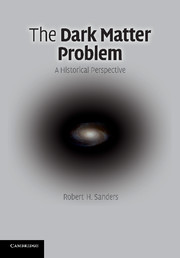Book contents
- Frontmatter
- Contents
- Acknowledgements
- 1 Introduction
- 2 Early history of the dark matter hypothesis
- 3 The stability of disk galaxies: the dark-halo solution
- 4 Direct evidence: extended rotation curves of spiral galaxies
- 5 The maximum-disk: light traces mass
- 6 Cosmology and the birth of astroparticle physics
- 7 Clusters revisited: missing mass found
- 8 CDM confronts galaxy rotation curves
- 9 The new cosmology: introducing dark energy
- 10 An alternative to dark matter: modified Newtonian dynamics
- 11 Seeing dark matter: the theory and practice of detection
- 12 Reflections: a personal point of view
- Appendix Astronomy made simple
- References
- Index
12 - Reflections: a personal point of view
Published online by Cambridge University Press: 05 July 2014
- Frontmatter
- Contents
- Acknowledgements
- 1 Introduction
- 2 Early history of the dark matter hypothesis
- 3 The stability of disk galaxies: the dark-halo solution
- 4 Direct evidence: extended rotation curves of spiral galaxies
- 5 The maximum-disk: light traces mass
- 6 Cosmology and the birth of astroparticle physics
- 7 Clusters revisited: missing mass found
- 8 CDM confronts galaxy rotation curves
- 9 The new cosmology: introducing dark energy
- 10 An alternative to dark matter: modified Newtonian dynamics
- 11 Seeing dark matter: the theory and practice of detection
- 12 Reflections: a personal point of view
- Appendix Astronomy made simple
- References
- Index
Summary
The prevailing view of the Universe now is radically different than it was 40 years ago when I began my career as a professional astronomer. Then, the world was perceived to be essentially visible to our eyes and our instruments. Now less than 5% of the world is thought to be potentially visible, and even 90% of this normal baryonic component is not detected. The remainder of the mass-energy content of the Universe is thought to consist partly of dark matter that is unidentified, and primarily of dark energy of even more uncertain nature. The dark matter fills the Universe, promotes structure formation and accounts for the discrepancy between the visible and dynamical mass of bound astronomical systems such as galaxies and clusters; it is the major constituent of such systems. In order to cluster on the scale of galaxies at sufficiently early epochs, the dark matter must be essentially pressureless, i.e., non-relativistic at the time it decoupled from photons and other particles. The dark energy, which may be identified with the zero-point energy of the vacuum, causes the present accelerated expansion of the Universe and provides the 70% contribution to the density budget for the flat Universe required by observations of CMB anisotropies.
So the two primary constituents of the world are detected only by their dynamical effects: dark energy which affects in an observable way the expansion history of the Universe, and dark matter that clumps and dominates the mass budget of bound gravitating systems.
Information
- Type
- Chapter
- Information
- The Dark Matter ProblemA Historical Perspective, pp. 166 - 172Publisher: Cambridge University PressPrint publication year: 2010
